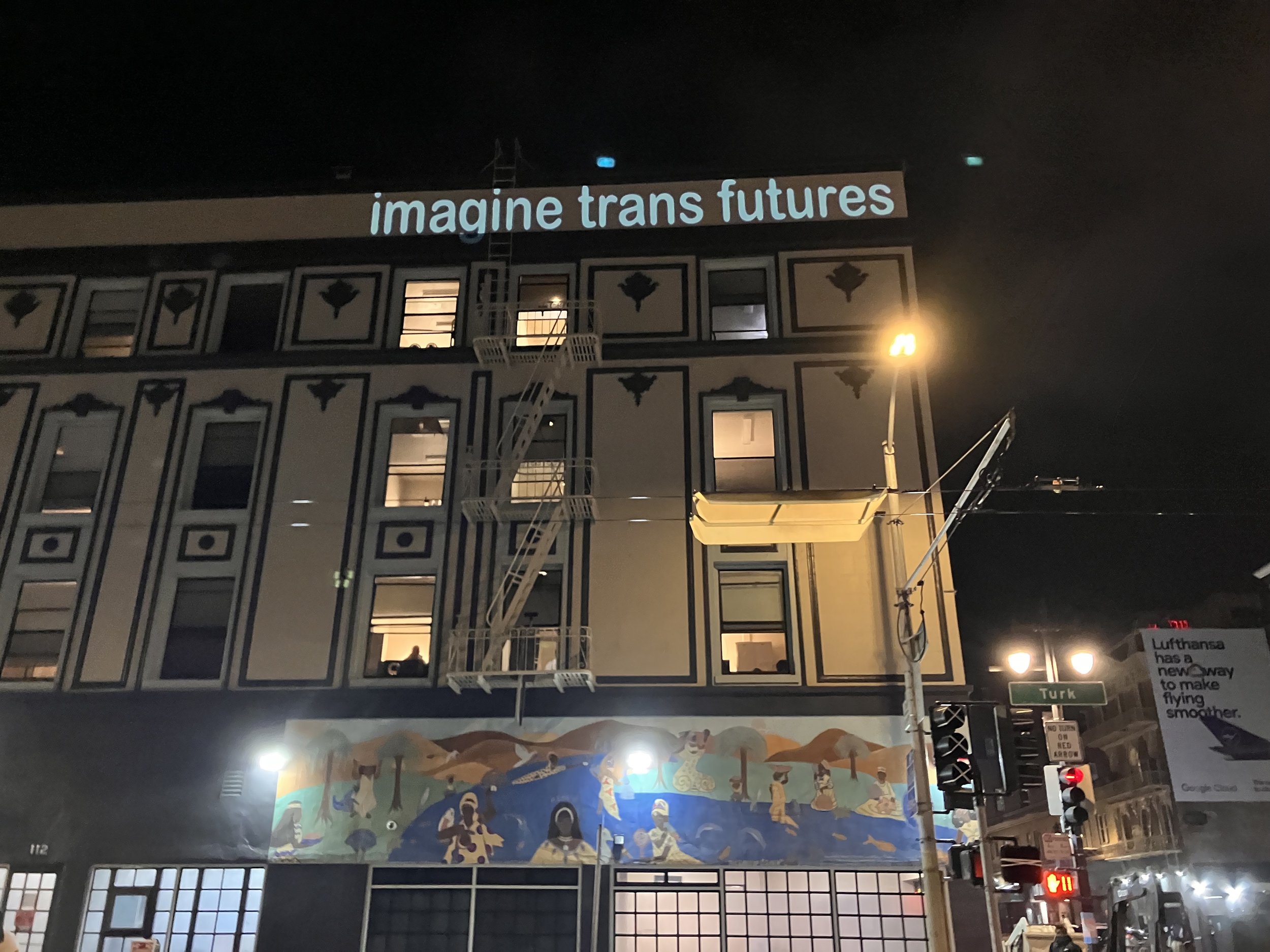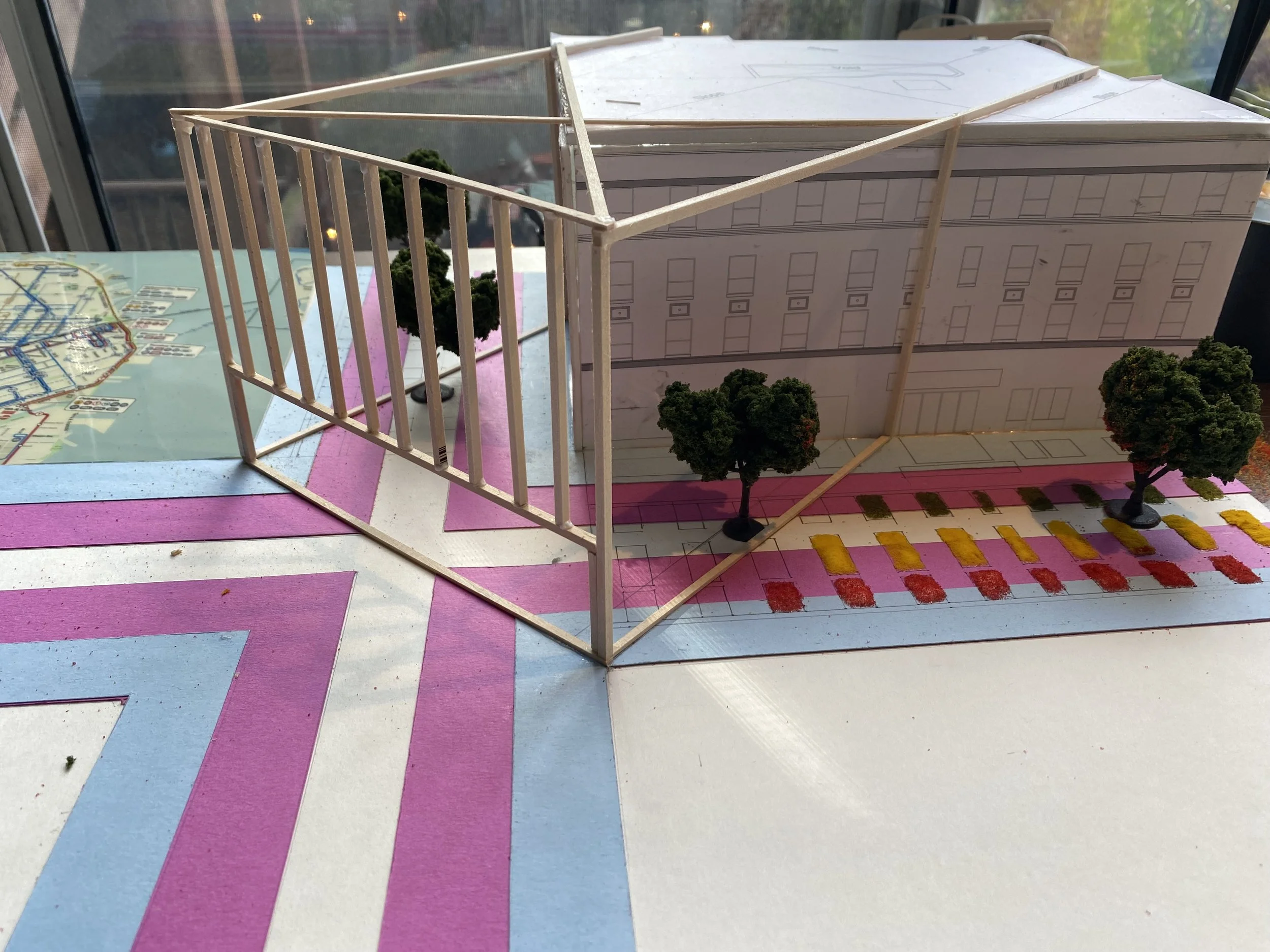
Speculative Design Workshop
We are continuing the effort to collectively imagine ways to reconfigure structures of power using the building at Turk and Taylor Streets as a representation of that transition. We aim to employ our collective imagination and creativity to disrupt and reconfigure oppressive societal frameworks. Drawing from historical protest actions such as the "Levitation of a Pentagon" in the 1970s, we intend to use the power of imagination to redefine what is possible.
Architects:
Isabella Torres, Spencer Bundoc, Stathis Yeros, Chandra Laborde, Ellen Herra, Helen Bronston.
Guest Advisor: Susan Stryker
PHASE 1 _CHARRETTE_ August 26, 2023 @ CounterPulse
〰️
PHASE 1 _CHARRETTE_ August 26, 2023 @ CounterPulse 〰️
Speculative Design Charrette Collages
Envisioning a Transfeminist Utopia
by Chandra Laborde
This speculative collage is a vision of the possibility of reworlding through selective unbuilding when using a male-to-female transsexual method to dismantle the categorical dichotomies that underpin patriarchal oppression. Although my inclination is to eliminate these structures completely, the pressing effects of climate collapse suggest an approach of deconstruction and salvage. In this vision, patriarchal structures of power undergo careful subtraction, containing space for transformation, while new forms emerge from the inside and establish new boundaries. Like a rhizomatic assemblage, this feminist reconfiguration unfolds its roots horizontally in a non-hierarchical way, disrupting imposed social patterns and transforming their meanings. The structure is partially buried within a compost pile made of the historical stratification of capitalist ruins, where luxury condos and high-end hotels are in different stages of decomposition. This sacred shellmound redefines the ontologies of waste through a decolonial practice that centers Indigenous spirituality as a mode of relationality that upholds justice.
Building and the Commons
by Stathis Yeros
Imagine a meadow growing among building debris methodically sorted and carefully re-positioned through everyday acts of collective defiance against a century of willful social conformity. How much of the building can turn to rubble and still be a building? The street elevation still bears the physical markers of its history: cheap lodging with narrow rooms--a single window, a bed, and a sink. As vegetation seeps through the cracks in the brick and concrete walls, the building’s transformation from the inside is made public. Between the meadow at the center and what remains of the perimeter walls, an activity zone mediates the transition from the city to the new commons. The activity zone is buzzing with arrivals, departures, community rituals, sex, new friendships, smells from open kitchens, and beds in dormitories arranged to sleep apart, together.
Shape and Background
by Isabella Torres
San Francisco stands as the epicenter, having taken risks and faced every adversity, particularly when challenging normativity and even nature itself, that is why it breaks sequences as reflected in its grid and urban planning. That shift in the city’s street grid that grew into a perfect orthogonal pattern suddenly takes a 40-degree turn to delimit the Latin area of the Mission, which for me, signifies the change and inclusion of the diversity reflected in its geometry. This is a reading that transitions from the quotidian to the permanent; transparencies and continuities superimposed in permanent harmony, reflecting innovation. The faces of its diverse people are also reflected in the facades of its architecture, which is why I propose the use in this intervention of the landmark of the building that housed our Trans history, with a double facade or “False” facade, which allows views to read and visually interpret that double face, and understand that we have been wrongly classified as having a double identity when it is society that judges with its double standards, that needs to change
Speculative collage
by Ellen M Herra
This is an explorative collage, what others may call diagnostic, although I do not think such language reflects the ethos of our collective approach. After a semester of theoretical contemplation and academic considerations of themes chosen by the initiative, we held a charette down the street from the building. As I walked around the surrounding streets to prime my mind for making this exploratory collage I tried to get a sense of what materials and methods of unbuilding and building were already taking place on the streets. I asked myself: what things eek out of the buildings that give a sense of how life is actually lived here and what shapes the nodes of interaction originating in the streets, how do these things come together to create a sense of place and express the existence of nonmaterial living practice. In the collage I focused on: graffiti as traces of recoding, reorganizing and shifting senses of ownership, cars as representative of temporary living and working spaces, and the untoward behaviors of people relieving themselves, smoking drugs and setting up living spaces with objects and music in the street. The interpretive object I incorporated was the figure of the Crone, the rhizome, and the b-side. The phrases on the college read: “I came here 2 leave/live” “Tin smoke” “in the darkness better” “collapsed vein/channel” “here somewhere be side you, b-sides” “wrinkle, envagination, tuck, glisten, trick” “bruised” “track” “the rhizome does not work alone, horizontal connects vertical interplays between hierarchy before falling back into disarray” and “I only know your facade Turk + Taylor.” The imagery shows an underlying wetland, a nature that we imagine was once here, transparencies and the building, unraveling, moving down and up, and creating a kind of collapsed spiral, that responds to the idea of an underground network pulling up and down on the grided structure.
Rebuilding Turk and Taylor means taking the physical, political, and emotional space of the rebellion as seriously as we take the buildings and streets.
It means letting the street and building and land and people merge, to create something seductive, strange, productive, and deeply rooted.
Dissolve the one to bridge and make space for a new way of relating each to each.
It means bringing what is repressed to the surface–what scares us, what frees us, and what supports us even as we deny it–as we reveal the spirit, flows, and essences of lives beyond law and reason.
Let this newly joint space – the living street, the passage building, the sidewalk weed grown Redwood-sized – become a new kind of public and publicity.
Expand this idea, from this corner, this block, to the city beyond
The land will speak of our together travel.
Wildflowers of a more humane humanity will bloom in a reborn and wiser Eden.
Let variety and dynamism devour the dead hand of history.
And let us tell the world.
Speculative Collage
by Spencer Budoc
This collage is inspired by the processes of horizontal organizing and the non-hierarchical power distribution of the Compton’s Cafeteria Riots that challenged the vertical power domination of police brutality and hyperpolicing. The horizontal-vertical oppositional power relationship is represented in the collage as cuts along the horizontal lines that run through the Turk and Taylor building that then separate the building into three layers, exposing the buildings interior. The piece is hopeful about the future while acknowledging historic ways of organizing, as it uses the riots that occurred at 111 Taylor St. as its precedent and inspiration.
Go tell ‘em, it’s another world
by Helen Bronston
PHASE 2 _CONCEPT_ September 2023
〰️
PHASE 2 _CONCEPT_ September 2023 〰️
Some ideas to think-with in the conceptual phase:
To disentangle the idea of structural reconfiguration, we can think about how structures of power are already represented in the building and the neighborhood (the prison industrial complex, surveillance, racism, genocide, colonialism, policing, street sweeping of encampments, lack of mental health services, private militias, gentrification, capitalist cooptation of trans bodies, performative ways of enacting care that don't help communities directly), and which are the ways of local resistance that we are inspired by (Compton’s Riot, trans kinship networks, solidarity, mutual aid between the unhoused, art practices, graffiti) to propose an alternative way or relating (non-hierarchical power, horizontality, the rhizome, community ownership, blurring private/public, connection/broadcasting, the figure of the Chrone), and how can we translate this way of relation into the current structure of the building. This action probably will need a practice of dismantling the existing structure or adapting it so it can be reconfigured into this alternative way of relating.
Remember that the exercise is speculative, so it makes it limitless, with no constraints. It is not an exercise of architectural design. We are working with abstract space, in the void of what can be. It is a utopian exercise of the conjuring of new realities.
>>> The most important thing to remember is that these alternative structures of social relations of power need to be reconfigured to make space for JUSTICE. That is why we are reconfiguring these structures. We are accessing power in this space of possibility and reconfiguring the way it is organized and distributed by imagining new ways of relating. Think, for example, of queer friendship as a way of resistance.
Another helpful topic we have been talking about is the theme of unbuilding. Unbuilding is helpful when talking about reconfiguring structures of power, not only because it is literally what we are doing, but because it also has a transexual understanding of the unbuilding of the body, of the capacity to re-signify what the body means, of how this unbuilding opens space for dismantling the structures of binary gender that are not only false but are oppressive and the basis of violence. In this way, the exercise is ontological, dealing with what things are, how they exist, and how things are categorized. The concept of selective unbuilding is also helpful because it opens space for change while commemorating what was once there. This concept also represents a helpful way to think-with in terms of power relations and the way they are internalized to unmake certain kinds of social relations that are normative
References
Halberstam, Jack. “Unbuilding Gender.” Places (Cambridge, Mass.), no. 2018 (2018). https://doi.org/10.22269/181003.
Hayward, Eva. “Spider City Sex.” Women & Performance 20, no. 3 (2010): 225–51. https://doi.org/10.1080/0740770X.2010.529244.
Weil, Abraham. “Transmolecular Revolutions.” In Deleuze, Guattari and the Schizoanalysis of Trans Studies, edited by Ciara Cremin, 121–50. Schizoanalytic Applications. London [England: Bloomsbury Academic, 2021.
Speculative Process Drawings

















